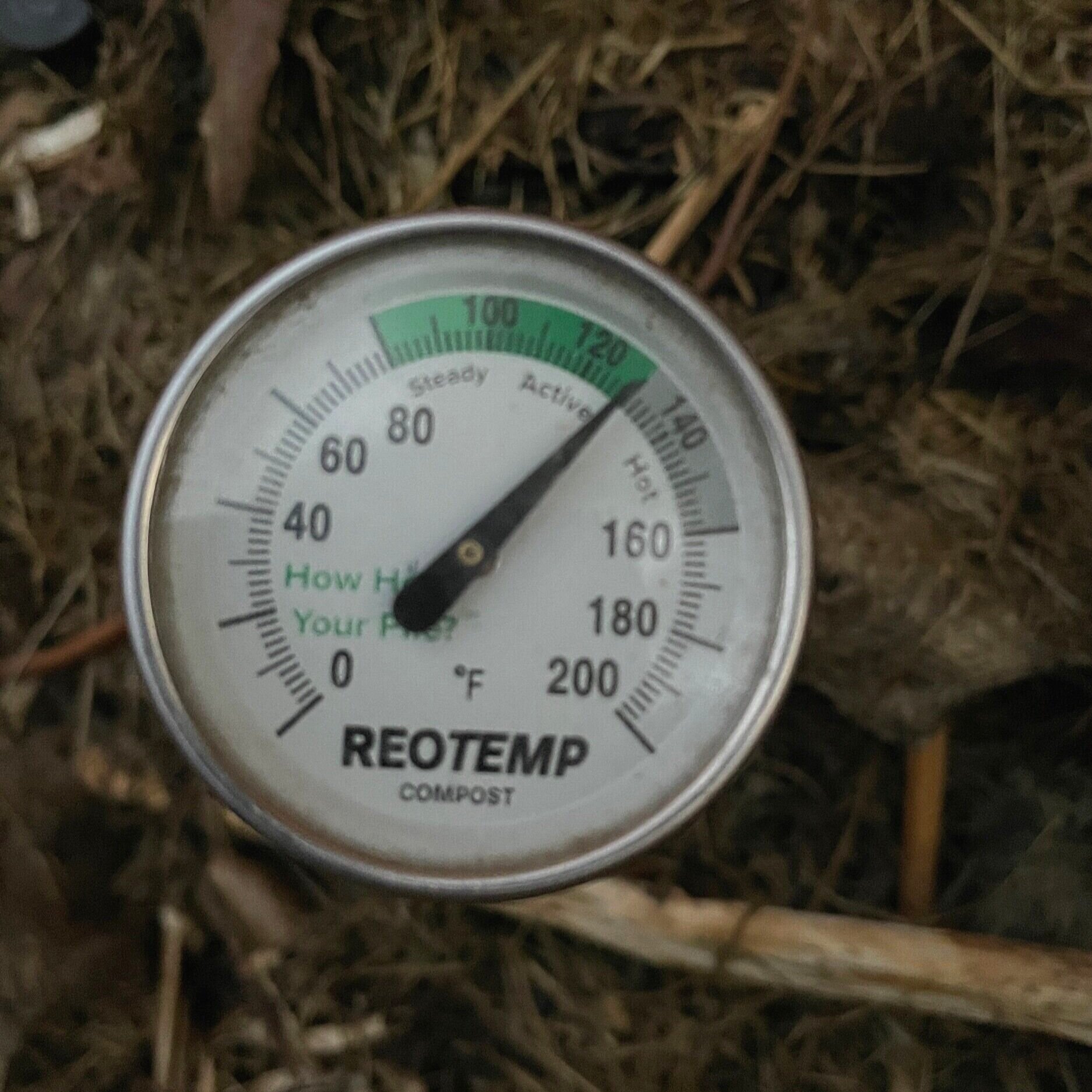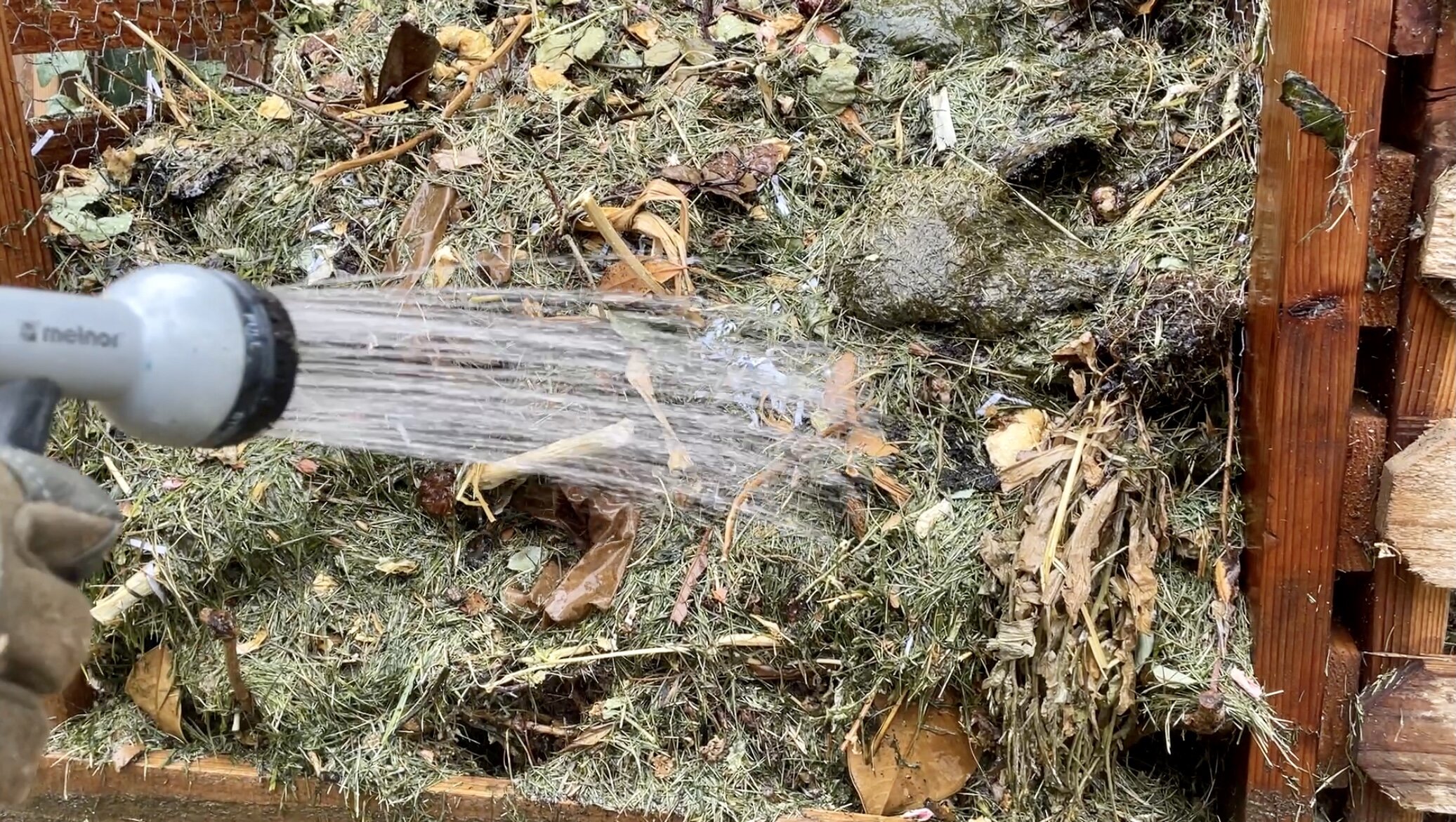How to Revive a Cold Compost Pile: A Guide to Hot Composting
This post may contain affiliate links. By clicking the link and making a purchase we receive a small commission at no additional cost to you! This helps us keep the lights on and continue to bring you great content.
Composting is an easy addition to any backyard garden. It gives you a way to turn household food waste and yard waste into ‘black gold’ that you can use in your garden to feed your soil. We have been composting here at Our Liberty House since 2014 and have tried a few different methods of composting but settled on what our current favorite is, which is the two-bin system. In short, a two-bin system is where one side cooks and breaks down organic matter while you continue to add and collect on the other side. The key to composting in a small space, like a backyard garden, is to keep your cooking side active. In this article, we will give you a breakdown of what hot composting is and how to keep your pile hot. We will also talk about how we revived a cold compost bin and how our experiment with trying the hot composting method went.
In our backyard garden, we love the 2-bin compost system. This way you can have an ‘active side’ and a side still available to collect. If you want to see how we built this, check out our article - DIY Compost Bin.
Cold, Active and Hot Composting
Cold composting is basically inactive composting. If you gather organic waste materials and throw them in a pile in the corner of your yard, it will compost and break down, but it will take a very long time. Hot composting can shorten that time dramatically and you can turn garden waste and food waste into compost in a couple of weeks. Hot composting requires bin turning every other day and quite a bit of attention. The benefits to hot composting is that you will get a final product the quickest, but the downfall is many beneficial organisms may die in the making (to include, perhaps, plant diseases or bad microorganisms).
We use a compost thermometer to help us better understand and control our compost pile
Active composting on the other hand, is somewhere in between. To achieve an active temperature in your bin (between 90 and 130 degrees Fahrenheit), you will want to turn and water your bin every week or every other week. This will achieve finished compost in a few months and maintain all the beneficial microorganisms. All three ways can result in a high-quality compost, it just depends on what you are composting and how much time and space you have to invest.
To determine what temperature your pile is, we recommend investing in a compost thermometer, we use and love this one, to make sure your compost pile is on track and stays in the active or hot range (depending one what you are going for.).
What Materials do you Want in Your Compost Pile?
When you think of compost many people think of ‘black gold’. It’s basically a super food of soil for your garden. It’s a densely nutrient packed soil made up of organic materials that gardeners top their garden with throughout the season to feed their plants. Compost is a mix of green materials and brown materials, also known as part nitrogen and part carbons respectively. The ratio of carbon vs nitrogen sometimes throws gardeners into a frenzy of measuring one vs. the other. In short, you want to have a higher ratio of carbons to your nitrogen, but honestly we have never measured and haven’t had much of an issue. So what are some examples of greens vs. browns? We will give you a short list of what we typically compost from our home garden:
Tip for garden waste: If you're able, cut up garden waste into smaller pieces or use a garden chipper (we use and love this one). Small pieces will break down faster and create beautifully crumbly compost.
A note on animal waste: Animal waste typically contains bad things, like parasites, which you do not want anywhere near your edible garden. These parasites can be killed in a hot composting process of obtaining 165 degrees fahrenheit for 5 days straight, but this is difficult to achieve in a backyard garden. Our recommendation is to simply avoid using any animal manure in your compost bin.
Greens aka. Nitrogens
kitchen scraps, but no meat waste
Egg shells
grass clippings and plant clippings (but these turn to carbons as they dry out)
Browns aka Carbons
coffee grounds
dry leaves
dried garden waste (those greens turn to browns)
shredded paper
wood chips / sawdust
If you want to dive further into the details of composting basics, and all the reasons we love composting, check out our Composting 101 article.
Rule of Caution with Hot Composting
Composting at high temperatures not only speeds up the composting process, but can also kill the beneficial microbial activity. Typically, if you’re achieving temperatures over 140 degrees Fahrenheit, you are risking killing all the benefits. However, on the opposite side of the spectrum you are also killing anything bad, such as weed seeds or diseased plants. So depending on your strategy you may want to avoid getting your pile too hot. For us, we still throw weeds and diseased plant scraps into our yard waste for the county to pick up and try to achieve an active compost bin, between 120-135 degrees Fahrenheit is our ideal temperature.
How to Get Your Pile Active?
If you have cold compost piles, meaning the temperature of the pile is below 80 degrees, there are ways to heat your pile up. The two basic ways to heat up your pile that work for us is turning the compost pile and keeping the pile moist. Ideally, you want the moisture level of your compost pile to be similar to a wrung out sponge. For general active compost (not hot compost), turning your compost once a week and soaking it in water is a great way to heat your pile up and create usable compost in a couple of months. We have used this method in the past and can get compost every 3-4 months on average.
*TIP* You can add a commercial compost starter like EB Stone Organics Compost Maker at the beginning to jump start your pile*
Finished Compost
How to Get Hot Compost?
If you're wanting to get usable compost even faster, or, if you have plant diseases in your compost bin, a hot compost bin is a good idea. We recently tried the hot composting method, sometimes referred to as the Berkeley Hot Composting Method*, and here's what we did:
Once you build your compost pile, turn and water your pile well then let it sit for 4 days. After 4 days have passed, check your pile and you'll likely see that the pile has heated up. Turn your pile on day 4 and continue to turn your pile every 2 days for the next 14 days. Your compost should stay between 130 and 150 degrees Fahrenheit. If done correctly, you should have a fine finished compost in 18 days. If your pile is not getting hot enough, you will need to add some nitrogen rich products such as garden waste, coffee grounds, or grass clippings. If the compost is getting too hot, you can add some high carbon scraps such as shredded cardboard, sawdust, or straw mulch. You will know the compost is finished when you have a homogeneous fine black product that will go great in your garden!
*Note, the true Berkeley Hot Composting Method has strict recommendations on how to layer your pile. We didn't follow those specific guidelines for our experiment.
A Few of Our Favorite Composting Tools:
Composting is a great way for homeowners to do a small part in keeping our plant green. By choosing to compost at home, you are saving a ton of waste from the landfill plus all those carbon emissions that it requires to haul your trash and garden waste there. We love our 2-bin composting system because it’s a great size for our small urban lot and is big enough to actively compost without taking up too much time or space. We hope you found this article helpful. If you’d like to learn more about composting, check out the articles below!
-Beth & Lucas
More Articles You May be Interested In:





